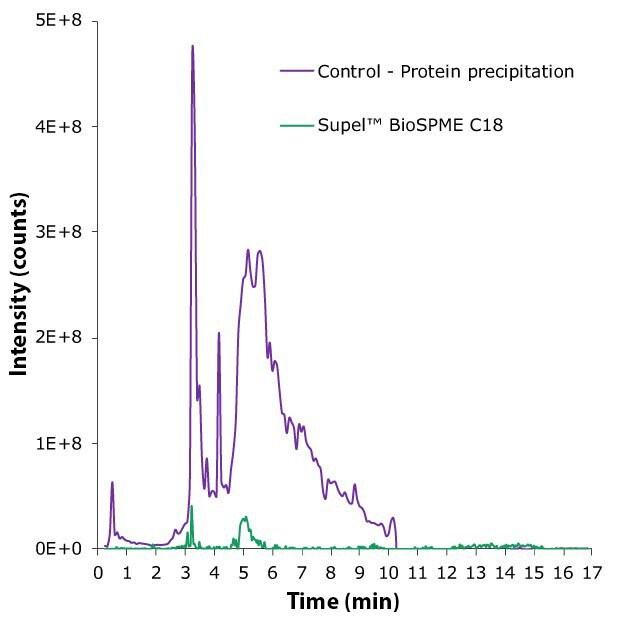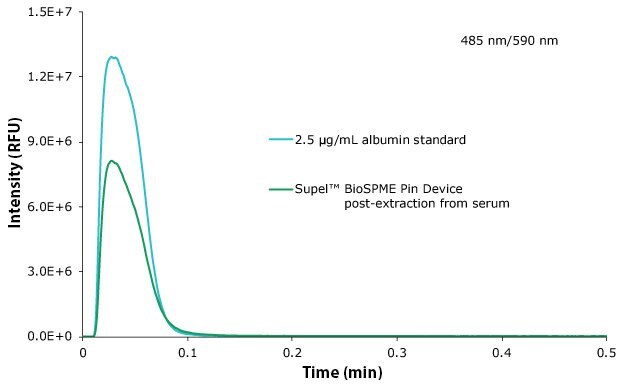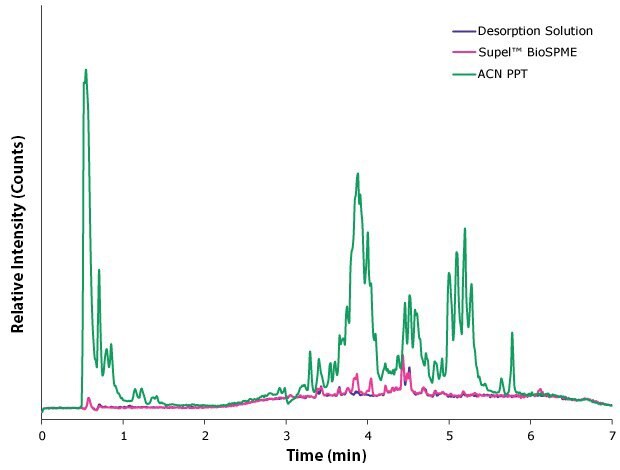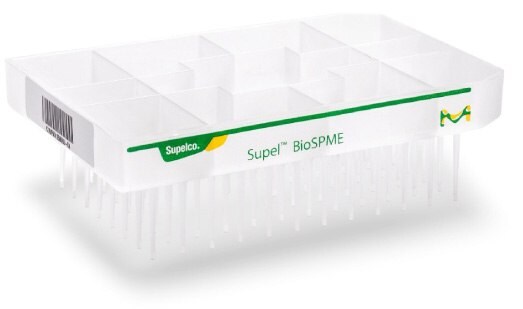Sample Cleanliness Using BioSPME
M. James Ross, Senior R&D Scientist, Olga Shimelis, R&D Manager
Merck
- Phospholipids Removal Efficiency: BioSPME Vs. Acetonitrile Protein Precipitation
- Albumin Protein Removal from Plasma
- Measuring Overall Sample Cleanliness by LC-MS/MS
- Results & Discussion: Supel™ BioSPME 96-PIN Device Outperforms Acetonitrile Based Sample Preparation
- Conclusion: Effective Sample Preparation with BioSPME
Sample preparation is performed to prepare the sample for analysis and to eliminate matrix effects. Matrix effects are exerted by endogenous species that may impede the signal of the desired analyte(s) from analysis.1 One analysis that is sensitive to matrix effects is LC-MS/MS. Plasma is a complex matrix that contains proteins, lipids, salts and carbohydrates which requires some sample preparation. Failure to address these concerns not only leads to potential matrix effects but also to increased analysis time, investment in new columns, or increased instrument maintenance time. In this study, we report the effectiveness of solid phase microextraction and the use of the Supel™ BioSPME C18 96-pin tool in preparing samples for analysis by LC-MS/MS. Previous work has demonstrated the ability of BioSPME in the preparation of samples for determination of protein binding values.2
PHOSPHOLIPIDS REMOVAL EFFICIENCY: BioSPME Vs. ACETONITRILE PROTEIN PRECIPITATION
The amount of phospholipids remaining in samples after extraction using the BioSPME 96-pin tool (Figure 1) was compared to the amount of phospholipids remaining after acetonitrile assisted protein precipitation. The BioSPME procedure is outlined in Figure 2. Briefly, the pin tool is conditioned in isopropanol, followed by a short rinse in water. At this point, the pin tool is ready for extraction. After extraction, the pin tool is rinsed briefly to remove any proteins that may remain on the pin’s surface before the analyte is desorbed and is then ready for analysis.
Protein precipitation was performed by using 100 µL human plasma and mixing with 300 µL of acetonitrile. The mixture was stored at 4 °C for 20 minutes before centrifugation at 5,000 rpm for 10 minutes. The supernatant was transferred and dried at 45 °C under a flow of nitrogen at 10 psi. The sample was then resuspended in 200 µL of the starting mobile phase.
Five samples from the two methods were analyzed on an AB Sciex-3200 Q Trap mass spectrometry with an Agilent 1290 LC using the method described in Table 1. The phospholipids that were monitored are listed in Table 2.
ALBUMIN PROTEIN REMOVAL FROM PLASMA
The amount of protein remaining in the extracted sample via non-specific retention on the pins was determined using a NanoOrange™ kit. The pins (eight) were conditioned for 20 minutes in 800 µL of isopropanol in a well-plate under static conditions. The pins were then washed for 10 seconds in 800 µL of water. Extraction of pooled human plasma (800 µL) took place from a 96-well plate while shaking at 1200 rpm, 3 mm orbital radius, and the thermo adapter set at 37 °C. Following extraction, the pins were washed for one minute in water.
Another well plate was prepared with 1 mL of the working solution (dye for protein staining) loaded into the appropriate wells of a well plate as described in the product directions. The pins used for bovine serum albumin (BSA) extraction were exposed to the working solution and allowed to react at 90-96 °C for 10 minutes while shaking at 300 rpm. The well plate was covered with foil to protect the samples from light. The samples were then cooled to room temperature.
The samples were analyzed on a Thermo Scientific Dionex HPLC instrument using fluorescence detector with direct flow (no column), see Table 3 for full details. Samples were quantified using the peak height using an external calibration in the range of 0.1 – 5.0 µg/mL of BSA.
MEASURING OVERALL SAMPLE CLEANLINESS BY LC-MS/MS
The cleanliness of the sample was determined by measuring the total ion chromatogram, TIC, for three sets of conditions: a control of the 80:20 desorption solution (methanol:water v/v), an extracted spiked plasma sample by BioSPME, and an acetonitrile assisted protein precipitated serum sample.
The acetonitrile assisted protein precipitated sample was prepared as followed. An aliquot of the spiked plasma corresponding to the plasma used in the extracted sample was diluted 3x with acetonitrile (v/v). This sample was then centrifuged for 10 minutes at 10,000 rpm at 4 °C. Upon completion, the supernatant was removed and dried under nitrogen at 10 psi and resuspended in the desorption solution to keep solvent effects to a minimum and better reflect sample cleanliness. All three samples were analyzed as described in Table 1, using a 2 µL injection with a Q1 scan between 100 to 900 m/z. Multiple methanol injections followed each sample of interest to remove carry over between samples.
RESULTS & DISCUSSION: Supel™ BioSPME 96-PIN DEVICE OUTPERFORMS ACETONITRILE BASED SAMPLE PREPARATION
Phospholipid amounts in the BioSPME prepared samples were compared to those of acetonitrile assisted protein precipitation prepared samples. As can be seen in Table 4, less than 0.1% of phospholipids remained in the final extracted sample using BioSPME compared to the acetonitrile assisted protein precipitated control. A sample chromatogram comparing the two conditions is shown in Figure 3.

Figure 3.Representative chromatograms (2 µL injections) for phospholipids in control sample (acetonitrile protein precipitated, purple) and the BioSPME sample (green).
From the NanoOrange™ studies, the pin tools accumulated approximately 1.2 µg of protein, quantified against BSA, on the surface of the pin. A representative chromatogram from a pin compared to a calibrator can be seen in Figure 4. Albumin accounts for over half of the total proteins in plasma (between 35 mg/mL to 50 mg/mL).3 This value correlates to less than 0.01% of proteins being in the final extracted sample as shown in Table 5 across the eight pins tested.

Figure 4.Representative chromatogram for albumin protein, extracted pin (blue), and 2.5 µg/mL standard (black).
To demonstrate that the sample is cleaner compared to a standard preparation, a full TIC was collected for a protein precipitated plasma sample, BioSPME extracted plasma sample, and desorption solution (see Figure 5). As seen, the BioSPME extracted sample is significantly closer to the desorption solution than the acetonitrile precipitated sample. The peaks that are observed in the desorption solution correspond to the deuterated carbamazepine present (RT ~4.5 min).

Figure 5.TIC chromatograms (5 µL injections) of phospholipids in protein precipitated sample (green), BioSPME extracted sample (pink), and desorption solution (blue). The chromatograms are adjusted to the same relative counts.
CONCLUSION: EFFECTIVE SAMPLE PREPARATION WITH BioSPME
This BioSPME 96-pin tool provides a quick and efficient means to deliver a clean sample with minimal matrix effects for analysis from human plasma.
Materials
References
如要继续阅读,请登录或创建帐户。
暂无帐户?